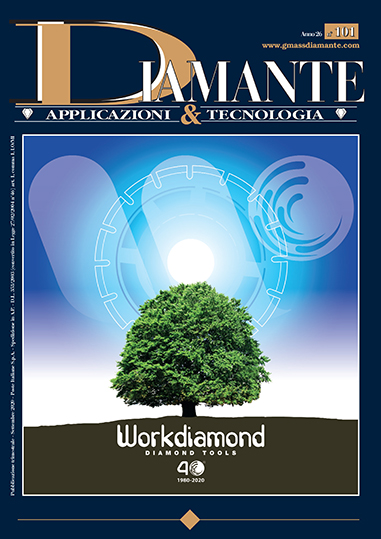|
Diamante A&T Contents Year XXVI - September 2020 |
|||||
|
Front Cover: WORKDIAMOND S.r.l. Since 40 years Workdiamond produces diamond tools for construction, shipbuilding and thermo-hydraulics, marble, granite and stone industry in general. In the Spotlight 10) Workdiamond, the first 40 years 12) Comil Plast, an excellence made in Italy 18) Marmomac Restart Digital Edition. The world of marble, networking and training just a click away Industrial Diamond 36) Differentiating performance of Polycrystalline Cubic Boron Nitride (PCBN) composite with nanostructured binder by C. Graham, A. Tomoda, M. Motchelaho, Å. Andersin, A. Can, M. Miranda, A. Thomasson, A. Malmquist, S. GhoshnElement Six
Abstract: A large part of ferrous machining, primarily finishing and semi-finishing operation, is carried out by polycrystalline
cubic boron nitride (PCBN) cutting tool material. Although PCBN cutting tool material operates under high temperature machining conditions (>800°C) in hardened steel
machining, an increased demand in productivity is pushing PCBN tool material to perform at even higher temperatures for longer durations. This requires PCBN cutting tools to
exhibit higher crater wear resistance and delay failure. PCBN is a composite material where binder phase plays a critical role along with CBN grain size and distribution.
It has been shown that a stronger bonding between the binder particles and CBN-binder particles enhances the wear resistance of the PCBN and reduces crack propagation
through the material. This paper looks at the influence of nano TiC/TiN material in PCBN (PureCutT platform from Element Six) as a means to achieve a stronger binder to
CBN particle bonding, and discusses improvements seen to the microstructure, mechanical behaviour and machining performance in interrupted finish machining.
The paper also analyses the influence of impurities on the sintering of nano TiC/TiN PCBN. Sintering 49) Study of elasto-plastic transition as affected by particle size during uniaxial cold compaction by M. Zago1, I. Cristofolini1, A. Molinari1, G. Pederzini2, A. Rambelli21University of Trento, Trento, Italy 2Sacmi Imola S.C., Powder Metal B.U., Imola, Italy Abstract: Compaction mechanics relationships describing the behaviour of AISI 316L powder mixes during uniaxial cold compaction
were derived in previous work by continuously recording the data of an industrial press. The reliability of the relationships depends on the accuracy in identifying the threshold of
elasto-plastic transition, what is a difficult task due to the peculiar characteristics of powder mixes. The influence of particle size on the transition threshold has
been investigated in the present work. Standard commercial AISI 316L powder was sieved in three particle sizes (fine - intermediate - coarse), 1% wt Acrawax was
added as a lubricant and ring-shaped parts were produced by uniaxial cold compaction. Processing the data recorded during compaction, the mean relative density corresponding
to the beginning of prevailing plastic deformation has been identified for all the powder mixes by means of a recursive procedure. The mechanisms responsible for the different
transition thresholds have been studied in depth. 59) Influence of compaction pressure on the anisotropy of sintering shrinkage of ring-shaped sponge and atomized iron parts by I. Cristofolini1, S. Amirabdollahian1, A. Molinari1, M. Larsson21University of Trento, Trento, Italy 2Höganäs AB, Höganäs, Sweden Abstract: The influence of green density and geometry on the anisotropy of sintering shrinkage of large rings (100 mm
external diameter, 42 mm internal diameter) produced with water atomized iron powder has been studied in previous work. In this work water atomized iron powder and sponge
iron powder have been used to produce small ring-shaped parts (40 mm external diameter, 20 mm internal diameter, three different heights), compacted up to five different compaction
pressures and sintered at 1120°C in low C potential endogas atmosphere (30 mins). Diameters and height of green and sintered specimens have been measured by CMM, and
dimensional changes, as well as change in volume, have been derived. Data have been compared with previous sampling, and the influence of the several variables on the
anisotropic dimensional change has been highlighted, also evaluating the trend of the anisotropy coefficient K. News and Events 66) At 32.BI-MU to anticipate and meet the recovery of investments 4.0 Concrete Cutting 74) Repurposed bridge finds new life in British Columbia |
|||||

